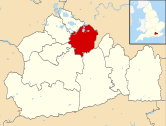Moulsey Hurst
Moulsey Hurst is in West Molesey, Surrey on the south bank of the River Thames above Molesey Lock. It is one of England's oldest sporting venues and was used in the 18th and 19th centuries for cricket, prizefighting and other sports.
The Thames at Moulsey Hurst | |
| Location | West Molesey, Surrey |
|---|---|
| Home club | Moulsey Hurst CC |
| County club | Surrey |
| Establishment | by 1726 |
| Last used | 1806 |
The site can be reached from Hampton across the river by Hampton Ferry when it is running in the summer.
Sporting venue
When James VI and I became King of England in 1603, he brought his golf clubs with him and the first games of golf in England were played at Molesey, Westminster and Greenwich which were large open spaces adjacent to royal palaces.[1]
This venue is considered to be one of the oldest used for organised cricket. The earliest known use of the site for the game was in 1723 for a match between Surrey and London.[2] One of cricket's most famous paintings is Cricket at Moulsey Hurst, by Richard Wilson in 1780. The painting is owned by MCC and on display at Lord's.[3]
It was the site of the now defunct Hurst Park horse race course. The 1872 Ordnance Survey map shows a race course marked Molesey Hurst in this position. The location of the cricket ground was probably in the centre of the racecourse, which was common practice in the 18th century. It was at this ground where the now modern-day East Molesey CC began, although the current ground now lies (albeit still on the bank of the River Thames) on Graburn Way, about a quarter of a mile further east and a short walk from Hampton Court Palace.
Molesey Hurst Golf Club (now defunct) was founded in 1907. The club disappeared at the onset of WW2.[4]
Other sports and activities included ballooning, sprinting and archery.
Moulsey Hurst today
In 2004, Hurst Park Residents Association laid out a "heritage marker" close to the river, which contains a number of illustrations of the history and activities of the area.[5]
Chronology of events
- 871 – Vikings sailed up the Thames here to sack Chertsey Abbey
- 1723 – the earliest known use of the site for cricket: Surrey v. London
- 1733 – earliest known use of the site for an inter-county match when Surrey played Middlesex
- May 1785 – James Sadler made a hot air balloon ascent near here, accompanied by a member of parliament, about a year after the success of the Montgolfier Brothers balloon
- Autumn 1787 – a professional runner named Powell ran a mile in 4 minutes and 3 seconds at Moulsey Hurst in preparation for an attempt on the 4-minute mile
- August 1795 – in a cricket match at Moulsey Hurst, John Tufton was dismissed leg before wicket (lbw) by John Wells; according to Arthur Haygarth[6] it was the first time lbw had ever been recorded in a scorecard
- 1798 – a Mr Troward, a member of the Toxophilite Society, shot an arrow on a level piece of ground on Moulsey Hurst seventeen score, or 340 yards
- 1806 – last known use of Moulsey Hurst for a first-class cricket match was a Surrey v England match.[7]
References
- Malcolm Campbell, Glynn Satterly The Scottish Golf Book
- Ian Maun (2009) From Commons to Lord's, Volume One: 1700 to 1750, p.27. Roger Heavens.
- David Underdown (2000) Start of Play. Allen Lane.
- “Molesey Hurst Golf Club”, "Golf's Missing Links".
- Peter Radford The Observer Sunday 2 May 2004
- Scores & Biographies, Volume 1 (1744–1826), Lillywhite, 1862, page 191. Haygarth says: In this match, "leg before wicket" is found scored for the first time. In Britcher's printed score-book, Mr J. Tufton is in this match put down as bowled merely, and the leg before wicket added in a note. At first, when any one was gotten out in this way, it was marked down as simply bowled, and the leg before wicket omitted
- Cricket Archive – Surrey v All-England
